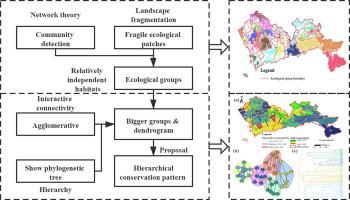Landscape and Urban Planning ( IF 9.1 ) Pub Date : 2021-03-11 , DOI: 10.1016/j.landurbplan.2021.104066 Yuhang Luo , Jiansheng Wu , Xiaoyu Wang , Yuhao Zhao , Zhe Feng

|
In the context of landscape fragmentation, a variety of ecological conservation theories have been proposed to maintain habitat connectivity. These theories focus on the connectivity of the ecological corridors in ecological space but ignore the community structure of ecological space. However, community structure is ubiquitous in ecological space. Our study predicted habitat quality of ecological patches by using an artificial neural network and species occurrence points. Then, the ecological space network (ESN) was proposed and constructed by taking large ecological patches and fragmented patches as habitat nodes. Based on island biogeography theory (TTIB) and network community detection, the ecological groups in the ESN were proposed and identified. They are considered to be collections of ecological land with close species connections. After that, the hierarchy of the ecological group was analyzed, and the existing policy was evaluated. The results show that there were 39 ecological groups in the ESN. The dendrogram of the hierarchy shows that all ecological groups can form five bigger ecological groups. The extent of the bigger groups proves that the ecological groups in the eastern part are closely connected. By analyzing the protection of ecological control lines on the linkages among ecological groups, we found that the existing policy could protect most of the ecological groups separately, but could not maintain connectivity among ecological groups, leading to habitat isolation. We believe that the concept of “ecological group” makes up for the lack of “habitat isolation” in the existing theory. The idea can understand the hierarchical structure of ecological space, which is conducive to the maintenance of ecological integrity.
中文翻译:

基于网络理论的景观破碎化生态群
在景观破碎化的背景下,提出了各种生态保护理论来维持生境的连通性。这些理论侧重于生态空间中生态走廊的连通性,却忽略了生态空间的群落结构。但是,社区结构在生态空间中无处不在。我们的研究通过使用人工神经网络和物种出现点来预测生态斑块的栖息地质量。然后,以大型生态斑块和零碎斑块为生境节点,提出并构建了生态空间网络。基于岛屿生物地理学理论(TTIB)和网络社区检测,提出并确定了ESN中的生态群。它们被认为是具有密切物种联系的生态土地的集合。之后,分析了生态群的层次结构,并对现有政策进行了评估。结果表明,ESN中有39个生态群。等级的树状图显示,所有生态群都可以形成五个更大的生态群。大群的程度证明了东部的生态群是紧密相连的。通过对生态群系之间联系的生态控制线的保护进行分析,我们发现现有的政策可以单独保护大多数生态群,但不能维持生态群之间的连通性,从而导致栖息地隔离。我们认为,“生态群体”的概念弥补了现有理论中缺乏“栖息地隔离”的不足。这个想法可以理解生态空间的层次结构,



























 京公网安备 11010802027423号
京公网安备 11010802027423号